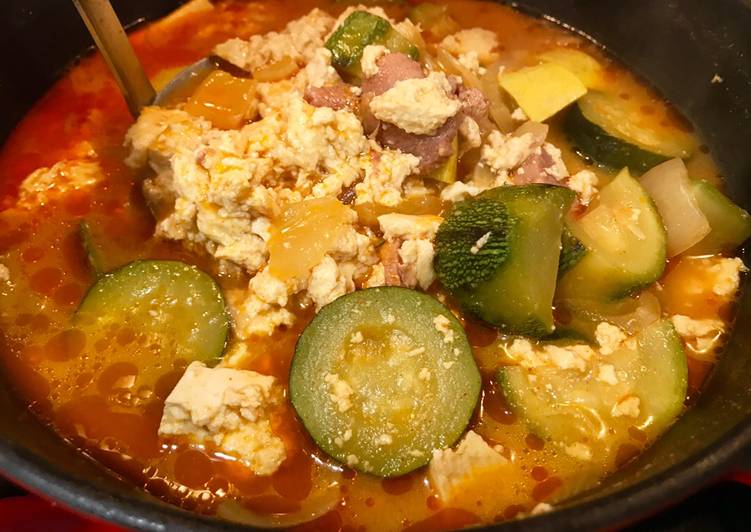Spicy Hobak Jjigae (Korean Squash Stew) with Pork & Tofu. Great recipe for Spicy Hobak Jjigae (Korean Squash Stew) with Pork & Tofu. Today's recipe is another simple and easy recipe, spicy pork stew or dwaejigogi-jjigae in Korean, a spicy, savory, juicy stew made with pork belly. Usually when I cook with pork I add kimchi, but this one doesn't have any kimchi at all.
 Cold weather is the best time to enjoy a steaming pot of spicy dish, especially with how cold the weather gets in Minnesota, this is the perfect time to share the recipe for Korean spicy pork zucchini stew.
Gochujang (fermented red chili pepper paste) is a condiment that's spicy, savory, slightly sweet, and pungent.
It adds lots of spicy, robust flavors to this simple stew which is made with a few very ordinary ingredients such as zucchini and potatoes.
You can have Spicy Hobak Jjigae (Korean Squash Stew) with Pork & Tofu using 9 ingredients and 5 steps. Here is how you achieve it.
Cold weather is the best time to enjoy a steaming pot of spicy dish, especially with how cold the weather gets in Minnesota, this is the perfect time to share the recipe for Korean spicy pork zucchini stew.
Gochujang (fermented red chili pepper paste) is a condiment that's spicy, savory, slightly sweet, and pungent.
It adds lots of spicy, robust flavors to this simple stew which is made with a few very ordinary ingredients such as zucchini and potatoes.
You can have Spicy Hobak Jjigae (Korean Squash Stew) with Pork & Tofu using 9 ingredients and 5 steps. Here is how you achieve it.
Ingredients of Spicy Hobak Jjigae (Korean Squash Stew) with Pork & Tofu
- You need 1/2 of onion, diced.
- It's 1-2 of jalapeños, cut into 1/8" thick slices.
- Prepare 2-4 of garlic cloves peeled and smashed (or chopped).
- Prepare 1/2 pound of pork shoulder, thinly sliced.
- It's 1/4 cup of dwenjang (Korean soybean paste) OR miso (which is the Japanese version).
- It's 1/4 cup of gochujang (Korean chili paste).
- Prepare 4 cups of water.
- It's 4 cups of calabacita squash or zucchini, cut into 1/2" thick slices (about 2 to 3 medium squashes).
- You need 1 (14 oz.) of package tofu (can be any firmness).
Easier and a bit more approachable than absolutely authentic kimchi jjigae. I took the Korean fish stock out of the recipe. No pulling the guts out of dried anchovies here. Just some simple chicken stock instead.
Spicy Hobak Jjigae (Korean Squash Stew) with Pork & Tofu step by step
- Put all ingredients except squash and tofu in a pot, cover, turn the heat to medium high, and cook for 15 minutes..
- Give the jjigae a few good stirs. You'll see the jjigae change color as the dwenjang and gochujang dissolve into the broth. Let the jjigae continue cooking uncovered for 2 to 3 minutes until it comes to a boil..
- Add squash, give it a few good stirs, and cook another 15 minutes covered..
- Crumble tofu into the jjigae. (This is not typical - usually it's cut into cubes or slices - but I like it this way because the tofu picks up more flavor from the broth.) Cover and cook another 10 minutes. Don't worry that the broth is constantly boiling rather than simmering. Jjigae gets its well developed pungency from this constant application of higher heat and the resulting compounding, melding, and reduction of flavors..
- At this point, give everything another good stir and see if you need to adjust the seasoning. If it tastes fine, you're done. If a little too salty, add a touch of water. If you want more saltiness, you can add a little more dwenjang and/or gochujang, remembering that the gochujang is much hotter (as in spicy) than the dwenjang. If you do adjust the seasoning, let it boil another 4 or 5 minutes to let the new level of seasoning meld. That's it. Enjoy!.
The world needs more pork belly. It's a bit fatty so it adds a wonderful richness to. Korean Soft Tofu Stew (Soon Du Bu Jigae) "Easy, fast, and flavorful with or without meat."- healthierbydesign. Dakdoritang (Korean Spicy Chicken Stew) "So delicious and flavorful. I can't get enough of this." - Jake Harrington.